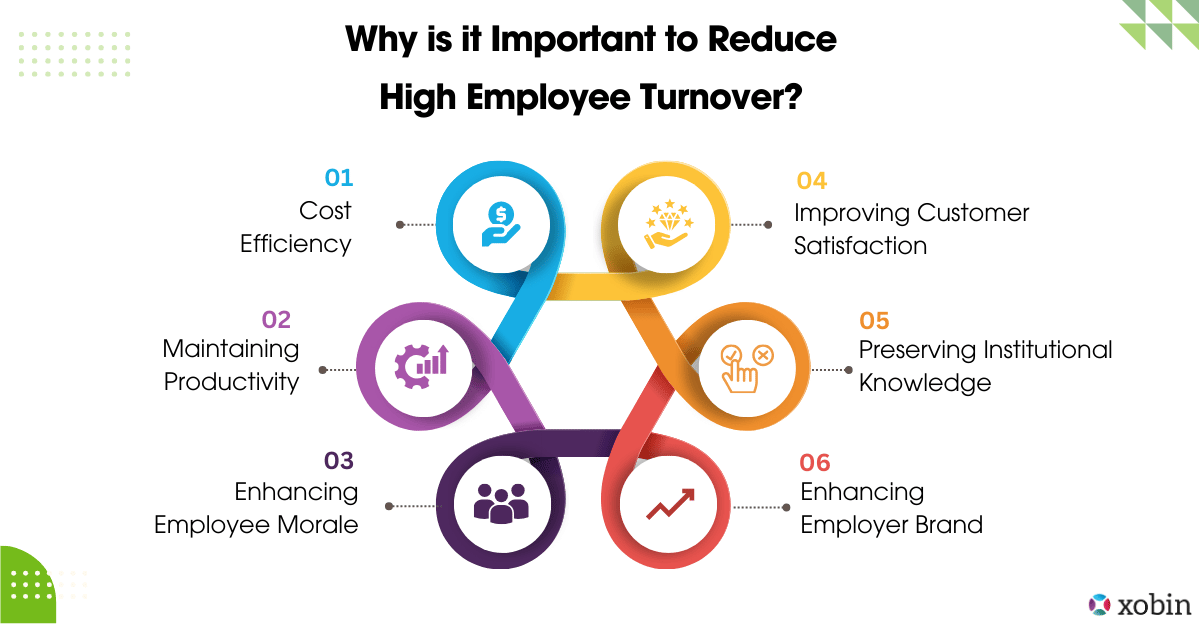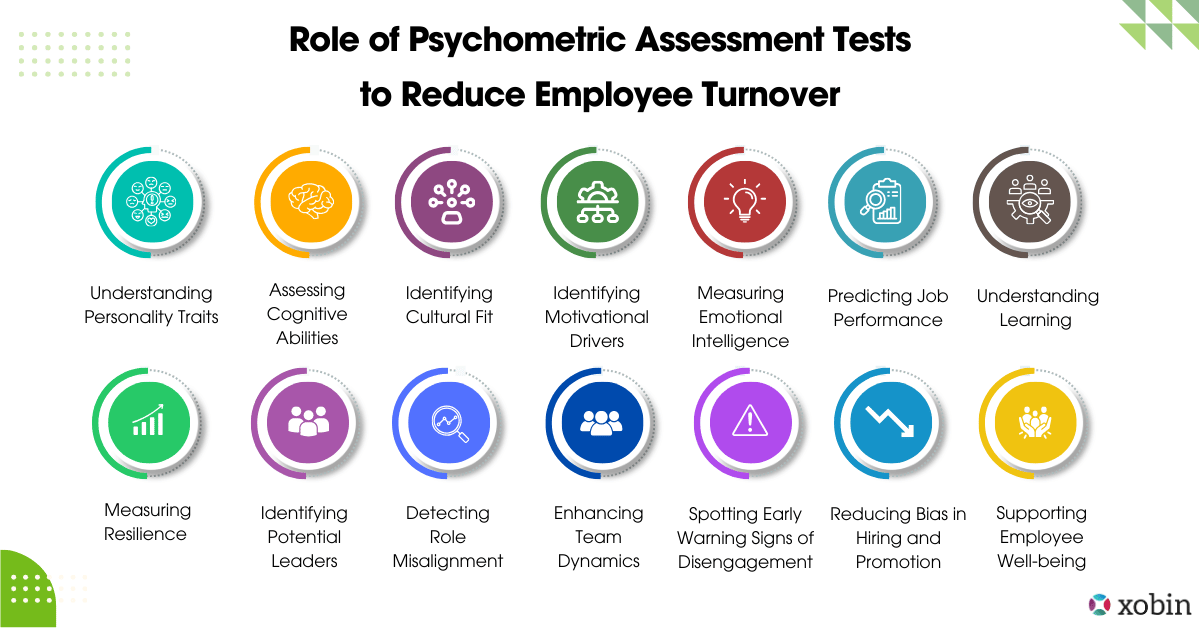
Many companies face a serious problem with employee turnover. High turnover rates can disrupt business operations, increase recruitment costs, and affect team morale. One effective strategy to mitigate this issue is to use psychometric assessment tests. These assessments provide valuable insights into employees’ personalities, strengths, and weaknesses, enabling them to make better hiring and management decisions. This blog explores how organizations can reduce employee turnover with psychometric testing and contribute to a more stable and productive workforce.
Looking for Psychometric Testing Software? Check out the Best Psychometric Testing Software
What is Employee Turnover?
The rate at which current employees leave a company and are replaced by fresh hires is known as employee turnover. This phenomenon can be both voluntary, such as when employees resign or retire, and involuntary, like during layoffs or terminations. High staff turnover may result in a rise in recruiting and training expenses, team morale issues, and operational disruptions.
The Job Seeker Nation Report reveals that 30% of employees quit within the first 90 days of their jobs. This indicates that managing turnover is crucial for maintaining organizational stability and productivity. Moreover, understanding and addressing the root causes of turnover can help businesses retain employees and achieve long-term success.
Why is it Important to Reduce High Employee Turnover?

High employee turnover is a pressing issue that can significantly impact an organization’s stability, morale, and profitability. Businesses must understand the underlying reasons for it and take proactive steps to mitigate its effects. Here are some reasons that reflect the need to reduce frequent employee turnover.
Cost Efficiency
One of the most immediate impacts of high employee turnover is the cost associated with recruiting, hiring and training new employees. These costs are not just financial. They also include the time and effort required from management and HR teams. When an employee heads out, the company must allocate resources to hire an appropriate replacement. This process can be lengthy and expensive. Moreover, high turnover rates can lead to increased hiring costs over time. Therefore, reducing turnover can lead to substantial savings, making it a crucial goal for businesses aiming at optimizing recruitment budget.
Maintaining Productivity
Productivity often suffers when employees leave. It takes time for new hires to get up to speed and reach the productivity levels of their predecessors. In the interim, existing employees may be stretched thin trying to cover the responsibilities of their departed colleagues. This can lead to burnout and decreased morale, further exacerbating the turnover problem. By reducing employee turnover, companies can maintain a steady level of productivity, ensuring that business operations continue smoothly and efficiently.
Enhancing Employee Morale
Employee turnover affects both those who leave and those who stay. When employees see their colleagues frequently leaving, it can create a sense of instability and uncertainty within the workplace. This can lead to decreased morale, lower job satisfaction, and, ultimately, a decline in overall performance. Conversely, a stable workforce fosters a sense of community and trust, boosting employee morale. Therefore, reducing turnover is essential for creating a positive and supportive work environment.
Improving Customer Satisfaction
Employees who stay with a company longer are more likely to develop stronger relationships with customers. They understand the company’s products, services, and values deeply, which translates into better customer service. High turnover disrupts these relationships, leading to a decline in customer satisfaction. Customers notice when they are frequently dealing with new representatives, and this can erode their trust in the company. By reducing employee turnover, businesses can ensure that their customers receive consistent and high-quality service, which is crucial for customer retention and satisfaction.
Preserving Institutional Knowledge
Long-term employees are valuable assets because they possess a wealth of institutional knowledge that cannot be easily replaced. This knowledge includes an understanding of company processes, relationships with clients and partners, and the intricacies of business operations. High employee turnover can lead to a significant loss of this knowledge, which can be detrimental to the company’s success. Retaining employees ensures that this knowledge remains within the organization, contributing to its long-term stability and growth.
Enhancing Employer Brand
As an employer, the reputation of the organization plays a crucial role in attracting and retaining talent. High employee turnover can damage this reputation, making it harder to attract top talent in the future. Potential candidates often research a company’s culture and turnover rates before deciding to apply. If they see a pattern of high turnover, they may perceive the company as a less desirable place to work. By reducing turnover, businesses can enhance their employer brand, making it easier to attract and retain skilled professionals.
Role of Psychometric Assessment Tests to Reduce Employee Turnover

Psychometric assessments offer a wealth of information that can help organizations better understand their employees and improve retention strategies. Here are key insights derived from these tests:
Understanding Personality Traits
One of the primary insights gained from psychometric evaluations is an understanding of personality traits. Personality test types such as the Myers-Briggs Type Indicator (MBTI) or the Big Five Personality Traits, assess characteristics like introversion versus extroversion, openness to experience, and emotional stability. Understanding these traits helps employers determine if a candidate’s personality aligns with the company culture and job requirements.
For example, Consider a company with a collaborative work environment that values teamwork and communication. If a candidate scores high on introversion and low on agreeableness, they may struggle in such a setting. Placing this candidate in a role that better suits their personality could reduce the likelihood of job dissatisfaction and eventual turnover.
Assessing Cognitive Abilities
Cognitive ability tests evaluate a candidate’s capacity to think critically, solve problems, and learn new information. These tests are crucial in determining how well an individual can adapt to the demands of a role. High cognitive ability often correlates with job performance, making it a strong predictor of success.
For example, in a fast-paced industry like technology, where rapid innovation is the norm, an employee with strong cognitive abilities will likely excel and thrive. If an organization hires individuals with lower cognitive skills for such roles, they may struggle to keep up, leading to frustration and higher turnover. By ensuring a match between cognitive abilities and job demands, companies can reduce turnover rates and enhance job satisfaction.
Identifying Cultural Fit
Psychometric tests can help determine if a candidate aligns with the company culture. For example, assessments that measure values, attitudes, and personality traits can reveal if an employee will thrive in a collaborative or competitive work environment. When employees feel that they belong, they are more likely to stay with the company long-term.
For example, a company that values teamwork might use psychometric tools to ensure new hires have high scores in cooperation and empathy, reducing the risk of turnover due to cultural misalignment.
Identifying Motivational Drivers
Understanding what motivates employees is crucial for retention. Psychometric assessment tests can uncover intrinsic and extrinsic motivational factors, such as a desire for recognition, financial rewards, or personal growth. By aligning job roles with these motivational drivers, companies can enhance employee satisfaction and decrease turnover.
For example, if a psychometric evaluation reveals that an employee is highly motivated by career advancement, providing clear paths for promotion could prevent them from seeking opportunities elsewhere.
Measuring Emotional Intelligence (EQ)
The capacity to recognize, comprehend, and regulate one’s own emotions and the emotions of others is known as emotional intelligence (EI). Employees who possess a high level of emotional intelligence tend to be more equipped to manage stress at work and sustain cordial interactions at work. Psychometric assessments that measure EI can identify individuals who are likely to handle workplace challenges effectively.
For example, a customer service representative with high EQ can more effectively navigate challenging customer interactions, leading to higher job satisfaction and lower stress levels. Conversely, a representative with low EQ might struggle with the emotional demands of the role, increasing the likelihood of burnout and turnover. Hence, companies can create a more resilient workforce by selecting candidates with high emotional intelligence for emotionally demanding roles.
Predicting Job Performance
Psychometric tests can predict how well an employee is likely to perform in a specific role. By analyzing traits such as conscientiousness, resilience, and adaptability, these assessments can forecast an employee’s job performance. High performers are less likely to leave, as they tend to feel more competent and satisfied in their roles.
For example, an employee who scores high on resilience is likely to perform well under pressure, making them less likely to leave during challenging times. This predictive capability allows organizations to make informed hiring and development decisions that reduce turnover.
Understanding Learning and Development Needs
Psychometric testing can highlight areas where employees may need further training or development. By addressing these needs proactively, companies can enhance employee competence and confidence, thereby reducing turnover.
For example, an employee struggling with time management might benefit from targeted training. This would lead to improved performance and reduced frustration, which in turn would lower the risk of their leaving.
Measuring Resilience and Adaptability
Resilience and adaptability are key traits in fast-paced and changing work environments, and they can be assessed through psychometric tests. Employees who score high in these areas are more likely to cope with changes and remain committed to the organization.
For example, a company undergoing frequent organizational changes can use psychometric assessments to identify employees who are resilient and adaptable, ensuring they remain engaged during transitions.
Identifying Potential Leaders
Leadership potential can be gauged through psychometric testing that assesses traits like decision-making, strategic thinking and interpersonal skills. Promoting employees who exhibit strong leadership potential can improve employee loyalty and engagement.
For example, an employee identified as a potential leader through psychometric testing might be given more responsibility. As a result, it could lead to increased job satisfaction and a lower likelihood of them seeking leadership roles elsewhere.
Detecting Role Misalignment
Sometimes, turnover is due to employees being in roles that do not match their skills or interests. Psychometric assessments can reveal whether an employee is well-suited for their current position or if they would perform better in a different role within the company.
For example, an employee who excels in creative thinking but struggles with routine tasks might be better suited to a role in product development rather than operations, reducing their risk of turnover.
Enhancing Team Dynamics
Psychometric assessments can also be used to build balanced teams with complementary skills and personalities. A well-constructed team is more likely to collaborate effectively, leading to higher job satisfaction and lower turnover rates.
For example, a company can use psychometric data in a workplace to combine team members with different personality traits to maximize productivity and workplace harmony.
Spotting Early Warning Signs of Disengagement
Regular psychometric evaluations can help in spotting early signs of employee disengagement. Changes in scores over time might indicate growing dissatisfaction, allowing companies to intervene before the employee decides to leave.
For example, an employee whose psychometric assessments show a decline in job satisfaction might benefit from a discussion with their manager about possible role adjustments, helping to re-engage them before they consider exiting the company.
Reducing Bias in Hiring and Promotion
Bias in hiring and promotion decisions can lead to employee dissatisfaction and turnover. Psychometric testing offers an objective way to assess candidates and employees, reducing the influence of unconscious bias.
For instance, instead of relying solely on subjective opinions, organizations can use psychometric data to make fair and informed decisions. This fairness fosters a positive work environment where employees feel valued and are less likely to leave.
Supporting Employee Well-being
Employee well-being is directly linked to turnover rates. Psychometric evaluations can identify employees who may be at risk of burnout or stress-related issues. For example, an assessment might reveal that an employee is struggling with work-life balance, prompting the organization to take proactive measures such as offering flexible working hours. Consequently, companies can prevent turnover by addressing well-being concerns early and promoting a more engaged workforce.
Reduce High Employee Turnover Rates 10x faster with Xobin’s Psychometric Testing Software
Effective psychometric testing software, like Xobin, plays a crucial role in reducing high employee turnover. It offers a strategic solution to address high turnover rates effectively. By utilizing advanced algorithms and data-driven insights, Xobin’s solution provides a comprehensive analysis of the personalities, skills, and cognitive abilities of candidates. This detailed assessment helps employers make informed hiring decisions, ensuring candidates are not only qualified but also a good cultural fit.
Xobin enhances the recruitment process by identifying potential red flags that might indicate future turnover risks. It enables organizations to match candidates with roles that align with their strengths and career aspirations, promoting long-term job satisfaction. Additionally, the ability to track and analyze employee performance over time allows businesses to address issues proactively before they lead to resignations. Therefore, integrating Xobin’s psychometric testing into your hiring and management processes not only improves recruitment outcomes but also significantly contributes to reducing high turnover rates, ensuring long-term organizational success.
Conclusion
Reducing employee turnover requires a proactive approach to understanding the needs and characteristics of your workforce. Psychometric evaluations offer a wealth of insights that can guide hiring decisions, ensure cultural alignment and identify opportunities for employee development. By leveraging these tools, companies can create a more satisfied, engaged, and stable workforce, ultimately reducing the costs and disruptions associated with high turnover. Implementing psychometric testing in your recruitment and employee development strategies is not just about reducing turnover. Still, it is about building a team that is well-suited, motivated and ready to contribute to your organization’s success.



